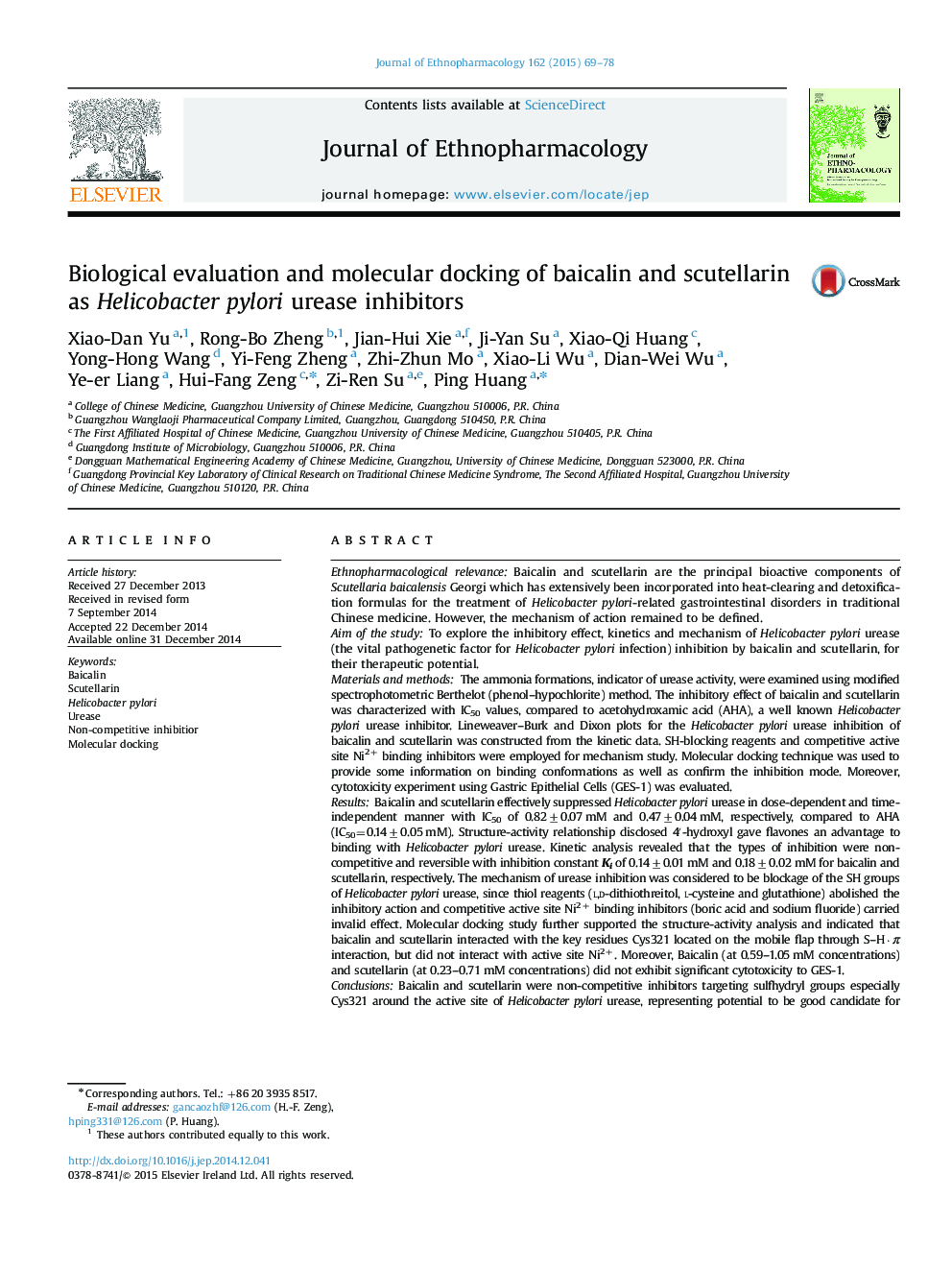| کد مقاله | کد نشریه | سال انتشار | مقاله انگلیسی | نسخه تمام متن |
|---|---|---|---|---|
| 5835409 | 1560400 | 2015 | 10 صفحه PDF | دانلود رایگان |

Ethnopharmacological relevanceBaicalin and scutellarin are the principal bioactive components of Scutellaria baicalensis Georgi which has extensively been incorporated into heat-clearing and detoxification formulas for the treatment of Helicobacter pylori-related gastrointestinal disorders in traditional Chinese medicine. However, the mechanism of action remained to be defined.Aim of the studyTo explore the inhibitory effect, kinetics and mechanism of Helicobacter pylori urease (the vital pathogenetic factor for Helicobacter pylori infection) inhibition by baicalin and scutellarin, for their therapeutic potential.Materials and methodsThe ammonia formations, indicator of urease activity, were examined using modified spectrophotometric Berthelot (phenol-hypochlorite) method. The inhibitory effect of baicalin and scutellarin was characterized with IC50 values, compared to acetohydroxamic acid (AHA), a well known Helicobacter pylori urease inhibitor. Lineweaver-Burk and Dixon plots for the Helicobacter pylori urease inhibition of baicalin and scutellarin was constructed from the kinetic data. SH-blocking reagents and competitive active site Ni2+ binding inhibitors were employed for mechanism study. Molecular docking technique was used to provide some information on binding conformations as well as confirm the inhibition mode. Moreover, cytotoxicity experiment using Gastric Epithelial Cells (GES-1) was evaluated.ResultsBaicalin and scutellarin effectively suppressed Helicobacter pylori urease in dose-dependent and time-independent manner with IC50 of 0.82±0.07 mM and 0.47±0.04 mM, respectively, compared to AHA (IC50=0.14±0.05 mM). Structure-activity relationship disclosed 4â²-hydroxyl gave flavones an advantage to binding with Helicobacter pylori urease. Kinetic analysis revealed that the types of inhibition were non-competitive and reversible with inhibition constant Ki of 0.14±0.01 mM and 0.18±0.02 mM for baicalin and scutellarin, respectively. The mechanism of urease inhibition was considered to be blockage of the SH groups of Helicobacter pylori urease, since thiol reagents (l,d-dithiothreitol, l-cysteine and glutathione) abolished the inhibitory action and competitive active site Ni2+ binding inhibitors (boric acid and sodium fluoride) carried invalid effect. Molecular docking study further supported the structure-activity analysis and indicated that baicalin and scutellarin interacted with the key residues Cys321 located on the mobile flap through SHÂ·Ï interaction, but did not interact with active site Ni2+. Moreover, Baicalin (at 0.59-1.05 mM concentrations) and scutellarin (at 0.23-0.71 mM concentrations) did not exhibit significant cytotoxicity to GES-1.ConclusionsBaicalin and scutellarin were non-competitive inhibitors targeting sulfhydryl groups especially Cys321 around the active site of Helicobacter pylori urease, representing potential to be good candidate for future research as urease inhibitor for treatment of Helicobacter pylori infection. Furthermore, our work gave additional scientific support to the use of Scutellaria baicalensis in traditional Chinese medicine (TCM) to treat gastrointestinal disorders.
173
Journal: Journal of Ethnopharmacology - Volume 162, 13 March 2015, Pages 69-78